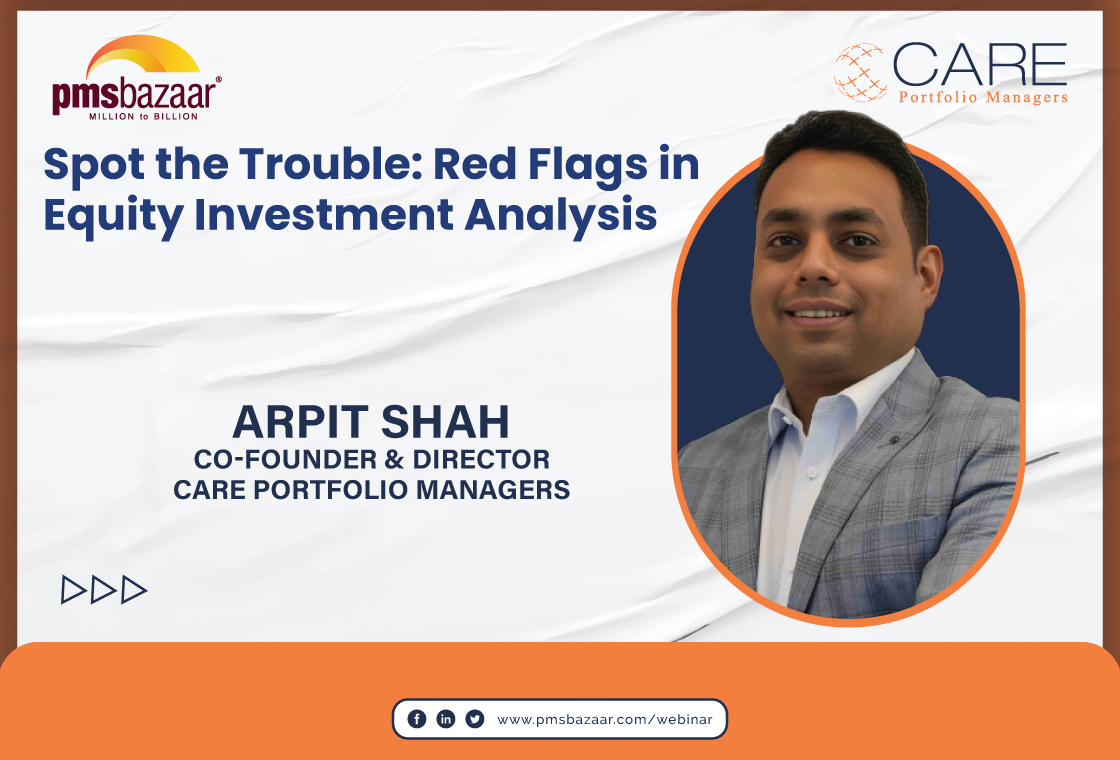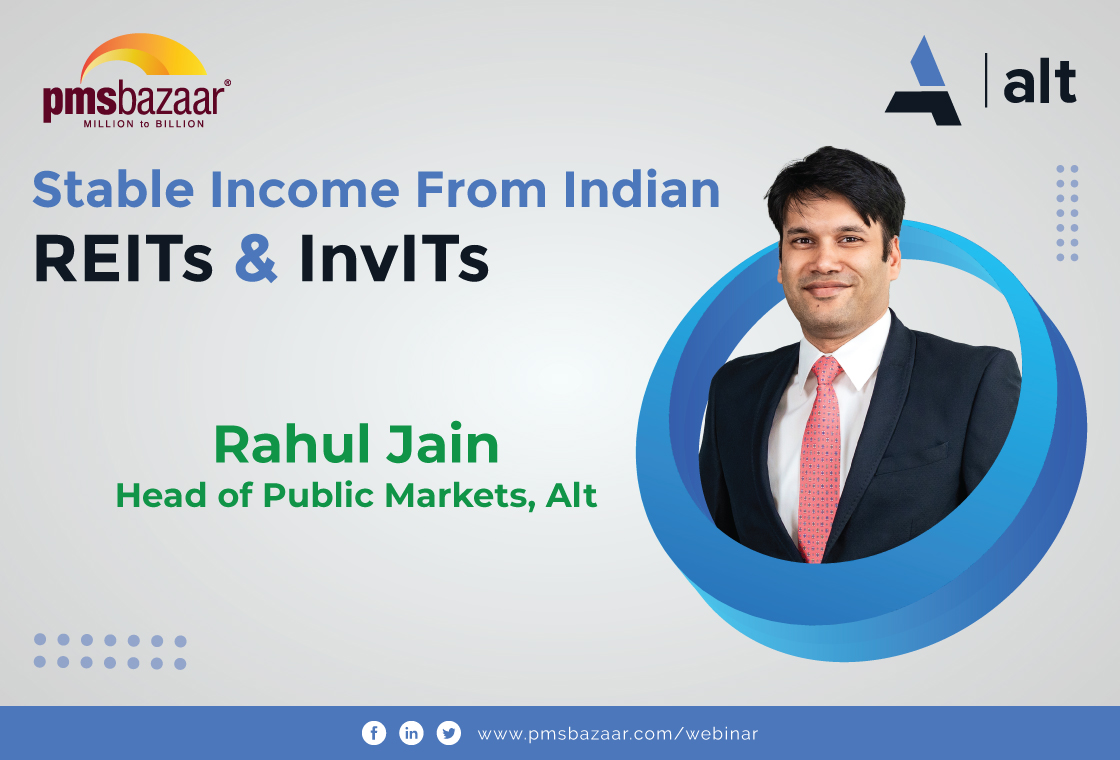PMS Bazaar recently organized a webinar titled “Quant Investing vs Traditional PMS: Can Quant Beat Human Intuition” which featured Mr. Vivek Sharma, Head of Investment, India, Estee Advisors. This blog covers the important points shared in this insightful webinar.

The webinar blog covers insights from Mr. Sharma, where he covered Estee's pioneering role in quant investing, highlighting the firm's systematic approach, key differences between quant and traditional investing, and the performance of their Long Alpha strategy. It also delves into risk management, portfolio construction, factor allocation, and the advantages of multi-factor strategies. Additionally, it discusses market regimes, diversification, and sentiment analysis in investment strategies.
Key aspects covered in this webinar blog are
- Overview of the webinar on quant investing vs traditional PMS
- Understanding quant investing: A data-driven approach
- Key differences between quant and traditional investing
- The Long Alpha strategy: Estee's flagship multi-factor model
- Risk management and optimising risk-adjusted returns
- Performance and market adaptability: The role of diversification
- Audience questions: Insights into portfolio construction and risk mitigation
Summary: Mr. Sharma provided insights into Estee, a leading company in systematic investing founded in 2008, leveraging quant-driven strategies. He highlighted key differences between quant and traditional investing, with quant focusing on data-driven, rule-based decision-making. Estee’s flagship Long Alpha strategy blends technical and fundamental factors to deliver low-volatility, high-return portfolios. Emphasizing diversification, risk management, and market regime understanding, Mr. Sharma discussed how their multi-factor approach ensures consistent performance, reduces volatility, and adapts to changing market conditions for optimal long-term returns.
Mr. Sharma provided an overview of Estee a pioneering company in systematic investments in India. Founded in 2008 during the formalisation of algorithmic trading, the firm was established with the aim of leveraging quant-driven trading and investment strategies. Today, Estee operates across six countries and manages over ₹1,500 crores in assets.
Quant Investing: A Systematic Approach
Quant investing relies on a rule-based methodology that uses vast amounts of historical data to develop and test hypotheses. For example, a common hypothesis might examine whether stocks that perform well in one month continue to deliver positive returns in the subsequent month. This systematic approach stands in stark contrast to traditional investing, which often relies on subjective judgment and emotional factors.
Mr. Sharma highlighted that quant strategies are particularly advantageous during stable market conditions, where they often outperform traditional approaches. However, he noted that during crises, such as the COVID-19 pandemic, traditional strategies may hold an edge due to their flexibility and human intuition.
Key Differences Between Quant and Traditional Investing
Mr. Sharma elaborated on the distinctions between quant and traditional investing:
- Systematic Rule-Based Approach: Quant investing utilises algorithms and backtested data to drive decisions, eliminating emotional biases.
- Human Bias Elimination: Quant strategies mitigate the risk of emotional influences, such as favouritism towards specific stocks or sectors, which can impact traditional approaches.
- Data-Driven Analysis: Quantitative models analyse extensive datasets, including financial metrics and competitor performance, to derive insights. In contrast, traditional investing often involves manual evaluations.
- Advanced Algorithms: Quant models integrate both technical and fundamental factors, ensuring comprehensive analysis. Traditional approaches may rely solely on qualitative assessments.
Performance of Quant Strategies
Mr. Sharma shared comparative data showcasing the performance of quant strategies versus traditional indices like NIFTY 50. Over a 13-year period, certain factors such as momentum, value, and low volatility consistently outperformed the NIFTY 50, underlining the long-term effectiveness of quant-based methodologies.
The Long Alpha Strategy
Highlighting Estee’s flagship product, the Long Alpha strategy, Mr. Sharma described it as a multi-factor quant model designed to outperform benchmark indices while maintaining low volatility. The strategy incorporates a blend of technical and fundamental factors and has demonstrated consistent success over its six-year track record.
The investment process for Long Alpha involves:
- Dynamic Factor Combination: Factors such as value, momentum, and quality are adjusted based on market regimes.
- Index Reconstitution Analysis: The strategy accounts for buying and selling pressures associated with stocks entering or exiting indices like NIFTY 50.
- Portfolio Optimisation: Portfolios are tailored for maximum risk-adjusted returns, balancing high performance with low volatility.
Benefits of Quant Models
Mr. Sharma highlighted several advantages of quant investing:
- Consistency: Quant models adhere to predefined rules, ensuring uniformity across market conditions.
- Risk Management: Investors gain clarity on the factors influencing portfolio performance, enabling effective adjustments.
- Comprehensive Market Coverage: Algorithms analyse extensive datasets quickly, offering a thorough market overview.
Understanding the Current Market Regime
Mr. Sharma emphasised the importance of understanding the prevailing market regime to design effective investment strategies. He explained that among the 130 micro-strategies available, they carefully evaluate which ones are most likely to succeed in the current environment. This process forms the foundation for constructing their long-only and long-alpha portfolios, incorporating thorough risk assessment. Factors such as sector and stock concentration are meticulously considered to ensure a balanced and well-structured portfolio.
Optimising Risk-Adjusted Returns
According to Mr. Sharma, the ultimate goal is to achieve the best risk-adjusted returns. He highlighted the consistent performance of their strategies since 2018, with a notable shift in methodology occurring in May 2019. Initially employing a single-factor methodology, they transitioned to a multi-factor approach that has significantly enhanced outcomes.
Performance Since the Revamp
Post-revamp in May 2019, the strategies have delivered gross returns almost double those of the S&P BSE 500. Mr. Sharma pointed out that while the BSE 500 yielded approximately 17%, their portfolio achieved a remarkable 32%. Importantly, this superior performance was not accompanied by increased volatility. Metrics such as standard deviation and maximum drawdown have demonstrated lower values than those of the BSE 500, reflecting a more stable investment approach.
Balancing Returns and Volatility
Mr. Sharma underscored the importance of balancing returns with risk. He noted that while many funds have achieved good alpha in recent years, the real measure of success lies in the risk taken to achieve those returns. Concentrated portfolios, he stated, often experience higher volatility and drawdowns. In contrast, their sector-agnostic approach ensures lower volatility while delivering robust returns.
Sector Allocation Trends
Highlighting sectoral diversification, Mr. Sharma shared insights into their allocation strategies over the past year. They have maintained an underweight position in financials and IT sectors while being overweight in consumer staples and healthcare. These allocations, driven by market regimes, illustrate the adaptability of their approach.
Market Capitalisation Diversification
Mr. Sharma explained their market cap diversification strategy, which typically involves a 40% allocation to mid-caps and 30% each to large and small caps. Over the last year, the large-cap allocation has risen from 20% to 30%, reflecting changes in market dynamics. He emphasised that these shifts are outcomes of their systematic portfolio construction process rather than arbitrary decisions.
Dynamic Factor Allocation
Discussing factor allocation, Mr. Sharma described how weightages are adjusted monthly based on the market regime. For example, momentum had close to zero allocation over the past year but has seen some allocation in recent months. Conversely, quality factors, which had significant weightage for most of the year, have been recently reduced. This dynamic approach allows their long-alpha strategy to adapt to changing market conditions effectively.
Audience Questions
Prioritizing Factors in Portfolio Construction
Mr. Sharma began by highlighting the complexities of portfolio construction, emphasizing a multi-factor approach to achieve optimal investment outcomes. He explained how conflicting signals from various factors are reconciled through a consolidated scoring system. For example, a stock with strong technical indicators but average fundamentals would be compared to another with above-average fundamentals and strong technicals. The latter would typically be preferred for its balanced performance.
Rule-Based Decision Making
Elaborating on the process, Mr. Sharma stressed the objectivity of rule-based decision-making. The selection and scoring of stocks rely on algorithms without human intervention. The system computes scores, selects the top-performing stocks, and assigns weights to minimize risk while optimizing returns. This ensures consistency and precision in portfolio management.
Single-Factor vs. Multi-Factor Strategies
Mr. Sharma addressed the limitations of single-factor strategies, such as momentum, which often deliver strong returns during bullish periods but face significant drawdowns in downturns. He cited examples like railway and defense stocks, which showed exceptional gains in favourable conditions but suffered up to 50% corrections during challenging times. In contrast, multi-factor strategies provide more consistent risk-adjusted returns, reducing volatility and aligning better with diverse investor risk tolerances.
Advantages of Multi-Factor Approaches
Multi-factor strategies shine through their ability to deliver stable returns over the long term. Mr. Sharma noted that single-factor strategies, such as value-based funds, often endure prolonged underperformance before recovering. In comparison, multi-factor strategies balance performance across various market conditions, making them ideal for wealth creation.
Risk Management Practices
Risk management is integral to Mr. Sharma’s portfolio strategy. By employing over 130 factors, they mitigate risk at multiple levels. Monthly portfolio rebalancing ensures swift exits from underperforming stocks, even though it incurs higher churn costs. This proactive approach has minimized losses to 15-20%, while the top-performing stocks delivered 50-100% returns.
Diversification and Alpha Generation
Mr. Sharma highlighted diversification as a cornerstone of their strategy, with portfolios containing around 80 stocks. This broad diversification, combined with multi-factor approaches, has consistently generated annualized returns of 15-16% over five years. He emphasized that such diversification is rare among portfolio management services and significantly enhances risk mitigation.
Sentiment Analysis and Innovation
Discussing investor sentiment, Mr. Sharma noted that momentum factors often capture market mood through price movements. He mentioned ongoing research into advanced sentiment analysis, such as evaluating market conversation tones. While these techniques are yet to show definitive advantages, they remain a key area of innovation.
Portfolio Rebalancing and Tax Implications
Monthly portfolio rebalancing ensures adaptability to changing market conditions. Mr. Sharma explained how their strategies balance churn costs with tax implications. Stocks with lower liquidity face penalties to prevent slippage, and portfolios are structured to mitigate short-term capital gains tax, optimizing risk-adjusted returns.
Market Regimes and Factor Weighting
Their algorithms adjust factor weightings based on market conditions. Aggressive factors like momentum dominate in bullish markets, while defensive factors, such as value, gain prominence during volatility. This systematic approach ensures portfolios remain resilient and aligned with prevailing market trends.
Expertise in Quant Funds
Reflecting on quant fund performance, Mr. Sharma emphasized the importance of experience and robust strategies. While seasoned funds excel even in challenging periods, newer ones often face difficulties in replicating backtested results. He stressed avoiding overfitting, which can lead to unreliable outcomes.
Sector Bias and Cash Calls
Their portfolios, comprising around 80 stocks, maintain balanced sector exposure. Occasionally, sector biases like consumer staples emerge due to systematic methodologies. Unlike some funds, his firm avoids cash calls, focusing instead on selecting defensive stocks to mitigate risks in adverse markets. By blending diversification, rule-based decision-making, and innovative strategies, Mr. Sharma’s approach exemplifies resilience and adaptability in portfolio management.
Mr. Vivek Sharma covered all the topics mentioned above in-depth and answered questions from the audience toward the end of the session. For more such insights on this webinar, watch the recording of this insightful session through the appended link below.
Get access to rich data and analytics of PMS & AIF by subscribing to us. Join the 75000+ investors & experts: Subscribe NOW
Recent Blogs
.jpg)
Passively Active Investing — A Modern Investor’s Lens on ETF-Based PMS
PMS Bazaar recently organized a webinar titled “Passively Active Investing — A Modern Investor’s Lens on ETF-Based PMS,” which featured Mr. Karan Bhatia, Co-Founder and Co-Fund Manager , Pricebridge Honeycomb ETF PMs. This blog covers the important points shared in this insightful webinar.

Spot the Trouble: Red Flags in Equity Investment Analysis
PMS Bazaar recently organized a webinar titled “Spot the Trouble: Red Flags in Equity Investment Analysis,” which featured Mr. Arpit Shah, Co-Founder & Director, Care Portfolio Managers. This blog covers the important points shared in this insightful webinar.

Long-Only AIFs Rebound Sharply in October; Long-Short Strategies Lag Despite Lower Volatility
106 long-only AIFs averaged 3.68% vs 32 long-short AIFs at 2.7%; only 24–31% of funds beat key indices

Markets log strongest monthly gains in 7 months; PMS performance turns near-uniform in October
Nifty 50 TRI gained 4.62%, BSE 500 TRI rose 4.27%; 415 of 427 equity PMSes ended positive

How SMEs are Shaping India’s Investment Landscape?
PMS Bazaar recently organized a webinar titled “How SMEs are Shaping India’s Investment Landscape?” which featured Mr. Shrikant Goyal, Fund Manager, GetFive Opportunity Fund.

Stable Income from Indian REITs and InvITs
PMS Bazaar recently organized a webinar titled “Stable Income from Indian REITs and InvITs,” which featured Mr. Rahul Jain, Head of Public Markets, Alt.

5 Key Considerations Before Investing in AIFs in India
Alternative Investment Funds (AIFs) have emerged as a compelling option for sophisticated investors seeking diversification and potentially superior returns. But venturing into AIFs requires a clear understanding of their unique characteristics that go beyond simply knowing what they are and their categories.

How AIF can help in diversification?
Traditionally, Indian investors have relied on a mix of stocks and bonds to build their wealth. While this approach offers diversification, it can still leave your portfolio vulnerable to market fluctuations. Enter Alternative Investment Funds (AIFs), a dynamic asset class gaining traction for its ability to unlock diversification beyond the realm of conventional options.

